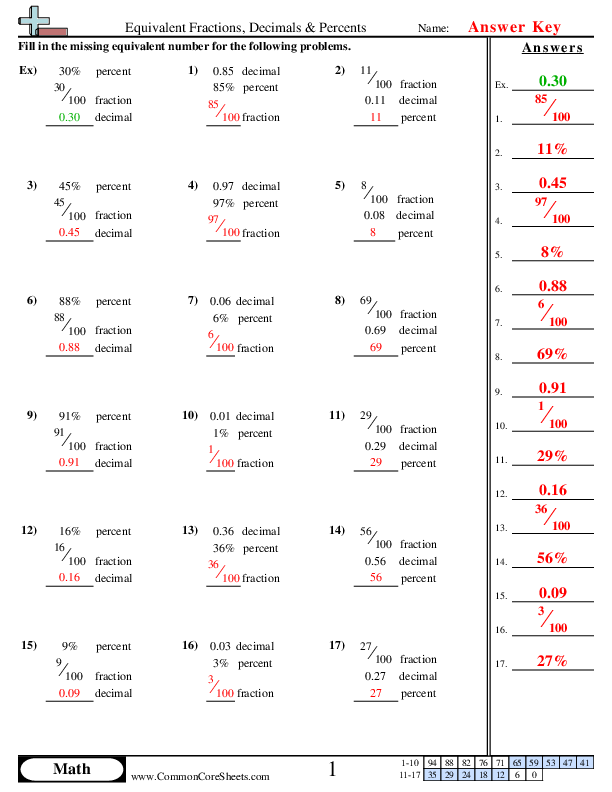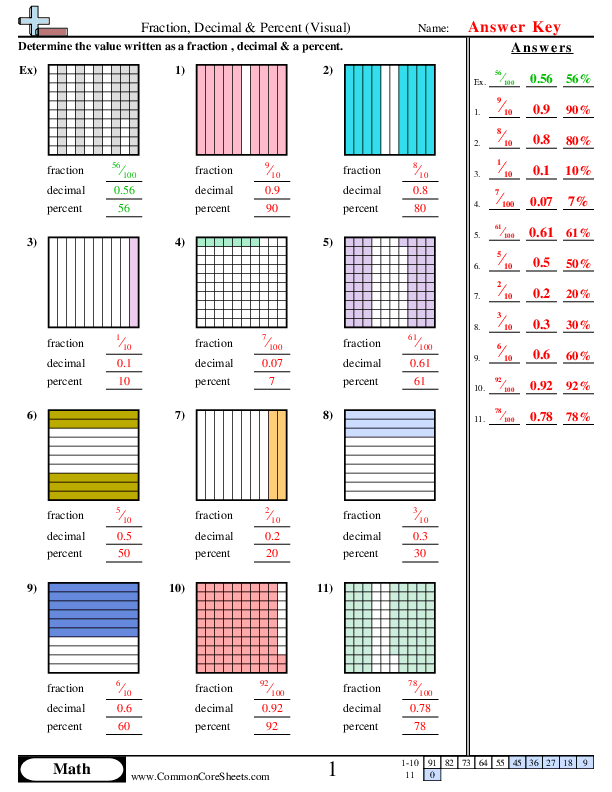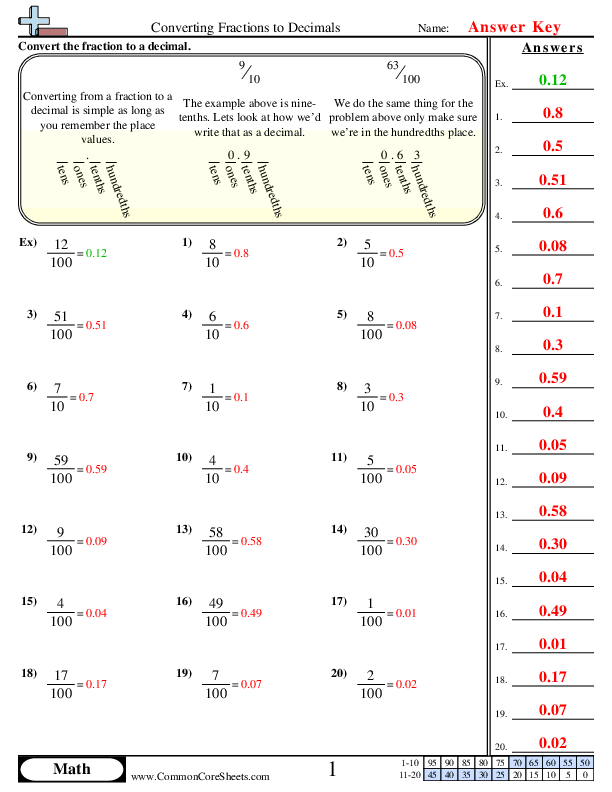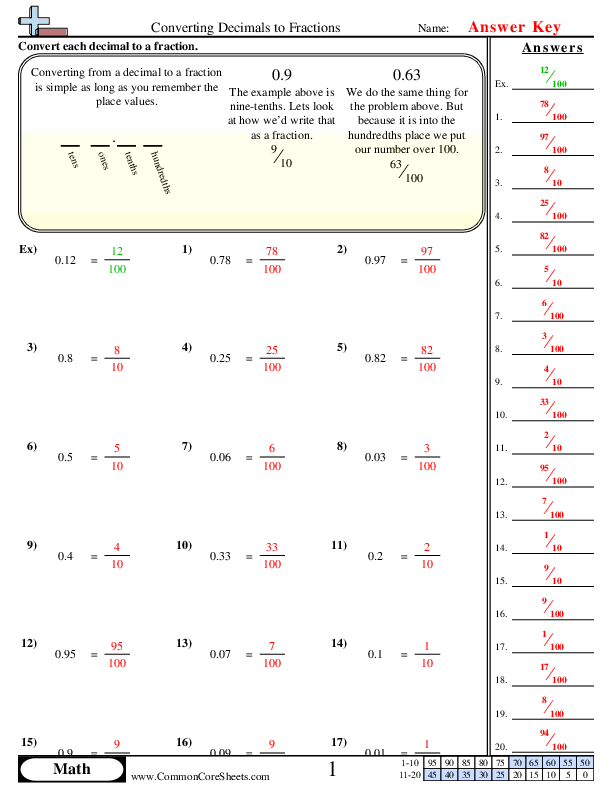Our converting forms worksheets are the best on the internet! Not only are they free, but they provide an invaluable aid in converting numbers from one form to another. With our converting forms worksheets, you'll quickly understand the fundamentals of conversions between fractions and decimals, numeric form to word form, and more. Plus, mastering these skills will come naturally as you work through our easy-to-follow worksheets. Get started today with the common core sheets' converting forms worksheets!
Browse Sheets By Problem Type
×

Word to Numeric Within 1 Million
4nbt2


×
Description:
"This worksheet is designed to enhance children's number writing skills up to 1 million. It includes 20 math problems that task learners to translate verbal descriptions of numbers into their numerical counterparts. This functional tool is versatile, enabling customization, conversion into flashcards, or use in distance learning contexts, fitting various learning strategies and environments for effective mathematical literacy development."

×
Student Goals:
Numeracy ProficiencyBy the conclusion of the worksheet, students are expected to gain a strong proficiency in understanding and writing numbers up to one million. This exercise will aid them to readily recognize and interpret large numbers in their numerical form, a vital skill in the mathematical field.Number ComprehensionAs they decipher the presented problems in verbal format and write them numerically, pupils will enhance their comprehension of the number system. This strengthens the foundations upon which more complex mathematical concepts and problem-solving skills will be built on in future lessons.Precision and AccuracyAccuracy is a key takeaway that students can obtain from such exercises. By learning to carefully write large numbers, they will enhance their sense of precision in conducting math-related tasks. This forms a crucial part of mastering the science of mathematics, where even a minor mistake can significantly alter the resultant answers.Conceptual UnderstandingStudents will gain a deeper conceptual understanding of numbers and their structure. By focusing on the place value system present within large numbers, learners will be able to visualize, understand, and illustrate the value of each digit in its respective position. This abstract understanding is a crucial step for higher-level arithmetic.Confidence BuildingDealing with large numbers can often intimidate or overwhelm students, especially beginners. However, after successfully reckoning these problems, they will develop a greater confidence and comfort in tackling similarly overwhelming number-related tasks in mathematics. This newfound confidence builds motivation and the courage to face challenging problems head-on.Application and Real-World ConnectionThe worksheet also encourages students to perceive the application of large numbers in the real world. Whether it's dealing with population numbers, monetary figures, measurement data, etc., their ability to understand and navigate such large numbers will equip them for real-world experiences.



Numeric to Word Within 1 Million
4nbt2


×
Description:
"This worksheet is designed to enhance children's math skills, specifically in writing numbers as words. It features 20 engaging problems that require students to transform numerical representation into verbal one. For instance, 6,434 becomes 'six thousand, four hundred thirty-four'. Flexibility is key, with options for customization, conversion into flash cards, and suitability for distance learning. A perfect tool to make math fun and accessible for all kids."

×
Student Goals:
Understanding Numbers and Their Written FormsAfter completing this worksheet, students should have a firmer understanding of how to translate numerical representations into their corresponding written forms. This is a critical skill for numerical comprehension, as it deepens their understanding of our numeration system. It will aid in their ability to recognize and utilize numbers in diverse ways and contexts.Enhancement in Mental ArithmeticWith the consistent practice provided by this fascinating worksheet, children will undeniably improve their mental arithmetic skills. This enhancement comes from internalizing the structural relationships between numbers as they translate them into words. This cognitive strengthening facilitates faster and more accurate mental calculations.Strengthened Problem-Solving AbilitiesThis worksheet supports the development of students' problem-solving capabilities. Children learn to examine and comprehend the systematic processes which are crucial for decoding the numerical problems. These abilities are not only advantageous in mathematics but also application in various disciplines and real-world situations.Improved Reading and Writing SkillsThis math worksheet indirectly allows students to strengthen their literacy skills. By translating numbers into words, students boost their vocabulary, improve their spelling, and enhance their understanding of grammatical rules. This exercise offers an interdisciplinary approach, mixing arithmetic with language arts, revealing the intertwined nature of knowledge.Build Confidence and Proficiency in MathCompleting the worksheet enhances students' confidence and proficiency in mathematics. It encourages children to retain and apply the basic concepts they have learned, promoting autonomy. As children work through the problems and successfully translate numbers into words, they will experience a sense of accomplishment that encourages continued learning and growth in mathematical proficiency.



Numeric to Expanded Within 1 Million
4nbt2


×
Description:
"This worksheet is designed to reinforce understanding of numeric to expanded forms within 1 million in math. Featuring 20 customized problems that can be converted into flash cards, it presents numbers like 10,288 in their expanded form to aid mental arithmetic. Its adaptability makes it ideal for distance learning, helping learners break down and comprehend larger numbers easily."

×
Student Goals:
Critical ThinkingBy completing this worksheet, students should be able to improve their critical thinking and problem-solving skills. This numeric form to expanded form exercise drills into students the ability to decompose numbers and understand the value of each digit in large numbers up to a million. As a result, their comprehension of number relationships and magnitude is enhanced, forming an essential aspect of their reasoning ability.Number SenseStudents will develop a strong number sense. They will be proficient in identifying and understanding the place value of each digit in numbers up to 1 million, from units to hundreds of thousands. This skill is fundamental to their numerical fluency, contributing to more advanced mathematical concepts along with their learning journey.Mathematical LanguageThis exercise aids students in developing their mathematical language and communication skills. They learn the terminology and symbology associated with expanded form, enabling them to accurately describe and record their mathematical ideas and understanding. This capacity is crucial for collaboration, oral and written mathematical communication in future learning settings.ConfidenceStudents should gain confidence in their mathematics abilities. By repeatedly practicing the breakdown of numbers into expanded forms, students will become comfortable and assured in working with large numbers. This confidence will enhance their approach to new mathematical challenges and reinforce a growth mindset in learning mathematics.Preparation for Advanced TopicsBy successfully accomplishing the worksheet, students will be well prepared for more complex math topics. Understanding expanded form is a key prerequisite for knowledge like adding, subtracting, and multiplying large numbers. Therefore, accomplishing this worksheet sets a strong foundation for their mathematical learning progression.Accuracy & SpeedStudents should achieve improved accuracy and speed. Regular practice with conversion of numeric forms to expanded forms can significantly improve the speed and precision with which students perform this process. This increased efficiency will be transferrable to other mathematical tasks, enhancing their overall academic productivity.



Fractions, Decimals & Percents (Numeric)
4nf6


×
Description:
"This worksheet is designed to aid in understanding the relation between fractions, decimals, and percentages. With 17 problems, it gives children hands-on practice in converting between these equivalent forms of numbers. Highly customizable, the worksheet can be adapted to fit different learners' needs, successfully converted into flashcards, or seamlessly integrated into distance learning curricula, providing an engaging tool to enhance math proficiency."

×
Student Goals:
Master the concept of equivalent fractions, decimals and percentagesAfter completing this worksheet, students should have a thorough understanding of the concept of equivalency among fractions, decimals, and percentages. They should be able to seamlessly convert a value from one form to another, showing a solid understanding of the integral relationships between these three mathematical representations.Develop computational skillsThis practice will foster students' computational skills, necessary for more advanced mathematical procedures. They would be well-versed with calculations involving the transition from fractions to decimals to percentages and vice-versa, enhancing their ability to calculate quickly and accurately.Promote problem-solving abilityBy working through the problems in this worksheet, students will improve their problem-solving skills. They will learn how to approach and solve complex problems involving fractions, decimals, and percentages. This practice will encourage critical thinking and logical reasoning, fundamental skills that are used in everyday life and other academic subjects.Amplify number senseCompletion of this worksheet will enhance students' number sense. It would promote a deeper understanding of the nature of numbers and their relationships, particularly in the context of fractions, percentages, and decimal values. This translates into improved mathematical intuition and a swift sense for number manipulation.Improve precision and attention to detailHandling fractions, decimals, and percents would help students fine-tune their precision and heighten their attentiveness to detail. As comprehension of these topics demands meticulous calculation and exactness, students will strengthen these qualities through consistent practice.Boost confidence in mathSuccessfully completing this worksheet means not only understanding the relationship between fractions, decimals, and percentages but also being adept at manipulating them. This mastery can result in greater confidence while facing math problems, which can in turn encourage a positive mindset towards learning new mathematical concepts.



Fraction, Decimal and Percent (Visual)
4nf6


×
Description:
"This worksheet is designed to enhance children's understanding of the correlation between fractions, decimals, and percentages using clear visual aids. It offers 11 unique problems, enabling students to apply their learned concepts practically. Educators can customize this versatile resource, creating flashcards for a more interactive experience or integrating it into distance learning curricula. This focused approach aids in building a solid foundation for more complex mathematical concepts."

×
Student Goals:
Understanding of Basic Mathematical RepresentationStudents should demonstrate a solid grasp of basic mathematical representation by successfully completing each problem in the worksheet. This includes understanding fractions, decimals, and percentages, and their relations. They should be able to confidently convert fractions to decimals and percentages, and vice versa, thus displaying proficiency in manipulating different mathematical forms.Mathematical Literacy DevelopmentBy the completion of the worksheet, students should have improved their mathematical literacy. They're set to have deepened their understanding of mathematical concepts and terminology, especially those pertaining to fractions, decimals, and percentages. A boosted level of mathematical literacy will make them better at quickly recognizing and processing mathematical patterns, which is a key skill that will benefit them in future advanced mathematical endeavors.Analytical Skills EnhancementAfter engaging with the worksheet, students are expected to have enhanced their analytical skills. By navigating from fractions to decimals to percentages, and correlating their common value, students will have strengthened their analytical thinking. This is a critical skill not just in mathematics but in problem-solving in other academic spheres and real-life situations. It helps develop an independent thinking process that is essential to make them successful learners.Comprehension of Practical ApplicationsUpon completion, students are projected to appreciate the practical applications of what they have learnt. Fractions, decimals, and percentages are not just theoretical mathematical concepts; they come to life in many everyday scenarios. Whether it's managing personal finances, planning baking recipes, or analyzing sports statistics, these concepts are widely used. Understanding them can thus empower students to navigate their everyday life more effectively.Confidence in Mathematical AbilitiesFinally, students should gain enhanced confidence in their mathematical abilities. Successfully solving these exercises will give them a strong sense of achievement and boost their academic confidence. This belief in their own capabilities will motivate them to approach more challenging mathematical problems in the future with less fear and more determination. In learning, confidence is key, and through mastering this worksheet, students are setting up a positive foundation for all future learning.



Converting Fractions to Decimals (10ths & 100ths)
4nf6


×
Description:
"This worksheet is designed to help children master the concept of converting fractions to decimals in a fun, engaging way. It offers 20 math problems where kids convert typical fractions into their decimal equivalents. Its interactive format offers adaptability and can be customized to suit individual learning needs. It could even be transformed into flash cards for additional practice or used in a distance learning environment to ensure continuous and effective learning."

×
Student Goals:
Understanding Fractions and DecimalsAfter completing the worksheet, students will have a clear understanding of how fractions and decimals are related. They will be able to effortlessly convert fractions to decimals and will know the underlying process behind it. This fundamental knowledge will allow them to navigate more complex math problems with ease.Mastery of Arithmetic SkillsBy practicing with twenty problems, students will achieve mastery in the arithmetic required to convert fractions into decimals. Their computation skills, coupled with an understanding of the place-value system used in decimals, will be significantly improved, enhancing their overall mathematical capabilities.Improved Problem-Solving SkillsThis worksheet is designed to foster mathematical inquiry, encouraging students to independently solve problems. After successful completion, they will have improved their problem-solving skills, which can be applied to other math topics and real-world scenarios.Boost in Mathematical ConfidenceBy successfully converting fractions to decimals, students will experience a significant boost in confidence, making them more likely to engage with mathematical topics in the future. This essential trust in their abilities can contribute positively to their overall academic performance.Preparation for Advanced Mathematical ConceptsThe knowledge of converting fractions to decimals is an integral part of more advanced mathematical concepts like algebra, percentage calculations, and data interpretation. Therefore, after completing the worksheet, students will be well-prepared for tackling these advanced topics when they encounter them.Enhancement of Analytical SkillsThe process of converting fractions to decimals involves step-by-step logical reasoning. As students navigate through these steps, they enhance their analytical skills — a trait that’s not only important in mathematics, but also beneficial in other subject areas and in everyday life.



Converting Decimals to Fractions (10ths & 100ths)
4nf6


×
Description:
"This worksheet is designed to instruct students on the subject of mathematics, specifically converting decimals to fractions. With 20 problems that visualize decimal values equaling to fractions, it provides engaging examples and practical exercises. Flexible for any learning environment, this worksheet is customizable, can be effortlessly converted into flash cards, and is suitable for distance learning, making it an adaptable educational resource."

×
Student Goals:
Understanding of Decimals and FractionsAfter completing the worksheet, students will have a firm understanding of decimals and their corresponding fractions. They should grasp the important concept that fractions and decimals are just two different ways of expressing the same value. This understanding provides a strong foundation for more advanced mathematical concepts.Conversion SkillsThe completion of the worksheet will equip learners with the necessary skills to convert decimals into fractions effortlessly. They will understand the systematic process involved in transforming a decimal into both its reduced and non-reduced fraction forms. This skill is central to many aspects of mathematics and is crucial for subsequent learning stages.Enhanced Problem-Solving AbilitiesWorking through the problems on this worksheet requires logical reasoning and problem-solving skills. The students will be better at diagnosing the problem, understanding the steps it takes to solve it, and applying this approach to different, yet similar problems. These enhanced abilities extend well beyond mathematics and are beneficial to all other subjects.Confidence in MathematicsSuccessfully converting decimals to fractions can boost the confidence of the learners. Building assurance in their mathematical abilities will encourage them to tackle more challenging problems without fear of failure. This confidence is pivotal in stimulating a positive attitude towards mathematics and other numeracy-based subjects.Preparation for Advanced MaterialThe ability to convert decimals to fractions is important in higher mathematical contexts such as algebra, geometry, and calculus. By honing these skills now, students will be better prepared to manage future mathematical coursework. This worksheet sets the groundwork for these critical, more advanced mathematical concepts.Real-World ApplicationThe ability to convert decimals to fractions has many practical, real-world applications, including but not limited to understanding scientific data, making accurate financial decisions, or even dividing recipes in cooking. By mastering this skill, students will be able to handle numbers in various real-life situations more efficiently.









